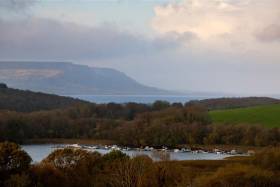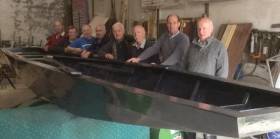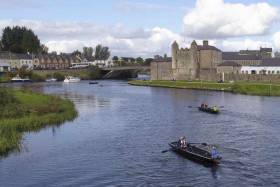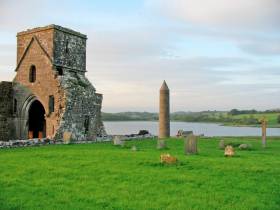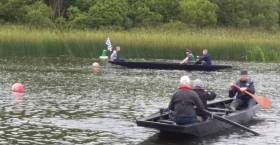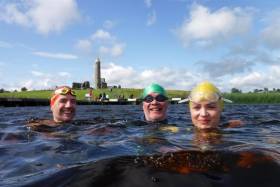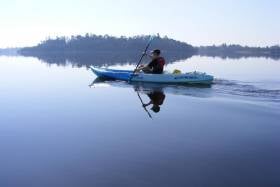Displaying items by tag: Lough Erne
Community Conversation In Fermanagh & Omagh
The Fermanagh and Omagh Community Planning Partnership are reviewing the content of their 2030 Community Plan as required by legislation.
To assist in the first stage of this process, they are undertaking a ‘light touch’ community engagement to reaffirm and prioritise the key priorities for the district — which includes Lough Erne — moving forward.
The engagement will close on Thursday 30 May. Interested parties can assist in the delivery of the 2030 Community Plan by taking a moment to complete a short survey HERE.
For further information, contact the Fermanagh and Omagh Community Planning and Performance Team on (+44) 0300 303 1777, text phone (+44) 028 8225 6216 or email [email protected].
Community-led planning is also in focus for Ireland's second largest lake, Lough Corrib, as previously reported on Afloat.ie.
Lough Erne Heritage Wins UK National Lottery Support For Programme To Preserve Area’s Boat Building History
A new community heritage project in Co Fermanagh focuses on raising awareness and preserving the heritage of traditional boat building and the cultural heritage of the people who lived on and around the shores of Lough Erne.
The ERNE Programme, which runs until June 2020, has been made possible by a UK National Lottery Heritage Fund award of £56,400 thanks to the money raised by lottery players.
This funding will help the programme establish a network of groups around Lough Erne, offer training opportunities for local volunteers to learn new skills, and develop a website with a ‘virtual museum’,
Other initiatives include interactive educational materials for schools, hosting Heritage in Action rowing regattas and an exhibition in June 2020 to showcase the heritage from around the inland waterway.
Welcoming the funding award, Gabriel Fitzpatrick, Lough Erne Heritage chair, said: “This project will enable local people to explore and share local history. We are pleased to have the opportunity to bring people together and tell the story.”
Jim McGreevy, of The National Lottery Heritage Fund’s NI committee, added: “We feel this project focusing on the strong boat building, rowing and associated heritage will complement our significant investment into the Lough Erne Landscape Partnership project.
“We’ve just launched our new five-year funding framework which outlines how we will continue to inspire, lead and resource the heritage sector.
“This new project is a great example of the projects we want to fund, it plans to explore important local heritage, involve a wider range of people in the project and to share everything that they uncover. We wish the project team well as they embark on their project.”
Formed in 2015, Lough Erne Heritage encourages research about Lough Erne, its traditional boats and the people who built and used them. In 2016, together with Cavan Town Men’s Shed, Lough Erne Heritage built two traditional Lough Erne Cots in order to demonstrate how they would have been used.
The Lough Erne Landscape Partnership is recruiting for the full-time position of Heritage Project Manager, based in Enniskillen, Co Fermanagh.
The successful candidate will work closely with local project partners, taking the lead on developing and delivering a suite of projects within the Lough Erne Landscape Partnership.
This “exciting” role will enable the right candidate to deliver projects to promote, protect and conserve the built, cultural and natural heritage of the Lough Erne area on and off the waterway.
The closing date for applications is Sunday 27 January. An application pack containing all information on the post is available from the LELP website.
Lough Erne Cots Race in Enniskillen For The First Time Since 1859!
On the 22nd and 23rd September, as a major part of Festival Lough Erne, two regattas for Lough Erne Cots were organised in Enniskillen by Lough Erne Heritage. Lough Erne Heritage is a registered charity formed as a constituted group in March 2015 to promote and preserve the maritime heritage of Lough Erne. Lough Erne Cots, unique to Lough Erne, were a key feature of so much of the transport of people, livestock and of imported and exported goods for hundreds of years on Lough Erne.
Used by the many people who lived on the islands and around the shores of the lough to support their work, they were also on special occasions raced as part of the celebrations on a holiday, for example, the Knockninny Regatta held in the 1800s and after the yacht races at Crom.
Some of the early regattas, or competitions between boats, have now been recreated by Lough Erne Heritage and others added, not only providing some fun and healthy exercise but also drawing attention to one of the main strands or aspects of the heritage of the lough, transport of goods and people by water.
Enniskillen Regatta on Saturday 22nd of September was the last in a series of five organised around Lough Erne throughout the summer of 2018. The others being Knockninny, Belleek, Belturbet and Crom. Whilst the Lough Erne Cots were provided by Lough Erne Heritage, the essential part of any regatta is the crews or teams and for this we were delighted with the support from Enniskillen Royal Grammar School boat club. Gaye Conway produced crews, some of world standard and just back from the championships in Bulgaria and some parents also supported the Regatta. One team of ladies from Row the Erne also took part. Racing took place between the Broadmeadow and the historic Irvine`s Island and in front of the viewing area on the walls of the Castle.
The winners were a team of world-class rowers from the boat club who called themselves Iain`s Men and consisting of Barney Rix, Ryan Ballantine and Michael Kennedy. To step from a modern racing machine into a craft whose design may go back 2000 years must have been quite a shock but greatly appreciated by the organisers. Runners-up were team Row the Erne, Clare Brogan, Deirdre O`Brien and Nadine Grant. Sadly neither team was able to take part in the Lough Erne Regatta the next day.
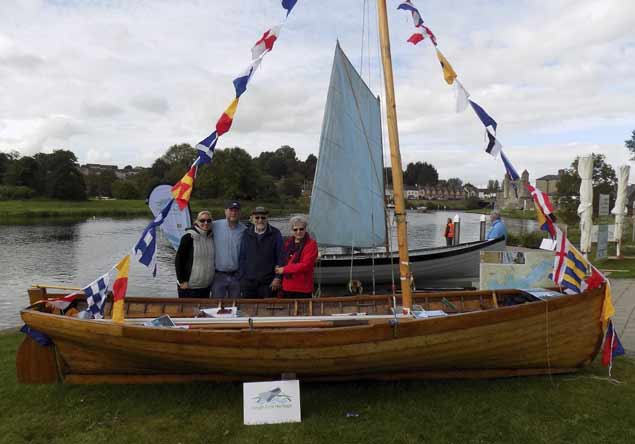 Tracy and James Hockley with his Lough Foyle Punt built 42 years ago by William Campbell who came down to the Regatta with his wife May. A Lough Erne Clinker Boat can be seen in the background with a sprit sail
Tracy and James Hockley with his Lough Foyle Punt built 42 years ago by William Campbell who came down to the Regatta with his wife May. A Lough Erne Clinker Boat can be seen in the background with a sprit sail
The Lough Erne Regatta the next day Sunday 23rd September saw teams gather from Knockninny, Belleek, Crom and Belturbet from where Tommy McMahon brought three Junior teams who had their own regatta within the Lough Erne Regatta. With the teams came many supporters who lined along the shore and cheered their teams on, all making a great spectacle. From a calm day on Saturday where the boats started from their marks downstream with the current, Sunday brought strong northerly winds so the boats started upstream against the current as the north wind was stronger than the current was. The regatta was run very efficiently and it was no time before the winners were announced. Of the three junior teams from Belturbet, the winning team consisted of Peter Lennon, Luke Malvanny and Josh McKiernan. The runners-up in the adult section were Team McGovern from Belleek and winners and Lough Erne Champions for 2018 was Team Murphy`s Boys.
Along with the regattas, on display was another Lough Erne cot built by Liam Boyle and a Lough Erne Clinker built rowing boat built by George and Fred Ternan. Visitors to the regatta for the weekend were James and Tracy Hockley from Derry who brought along their Lough Foyle Punt with the intention of demonstrating its sailing abilities on Sunday but sadly the demonstration had to be cancelled due to the strong winds. However whilst on display alongside the Lough Erne boats it attracted much interest and the builder, William Campbell and his wife May were on hand to explain how he built a number of these boats when living in Derry. A Drontheim from the north coast was also to be on display but had to be cancelled due to illness in the family. Had the three boats been on display the connection between the Lough Erne boats and those from the north coast would have been seen.
The regattas had three support boats on the water manned by Eugene Brazil, Liam Boyle and Brian Osbourne, very experienced lough men and all wearing Personal Flotation Devices, as did all the competitors. The support boats also set the course which involved four turning marks and two start marks. On shore was St. Johns ambulance and in the organising committee was an RYA Yachtmaster and from the world of sailboat racing an experienced National Race Officer. Great interest was displayed from the members of the public and it would appear that there will be more Lough Erne Cots on the water next year with more communities from around the lough becoming involved.
Altogether a very safe and enjoyable regatta involving many people from Fermanagh, Cavan, Donegal, Derry and further afield who gained a wonderful experience of the unique islands of Enniskillen and the perfect setting for the regatta where it is hoped to feature more traditional boats next year.
Sprit Sails & Clinker Boats on Lough Erne
In the 1800s and into the 1930s, double ended Clinker built boats, yawls, were seen and used on Lower Lough Erne. These historic boats were about 17 or 18 feet in length and about 5 feet wide and were propelled by oars or a Sprit sail writes Fred Ternan of Lough Erne Heritage.
They were very similar to the Drontheim used around the North coast and as far south as Donegal Bay. Drontheims would have been seen by the people from Lough Erne when trading with Ballyshannon and this may have brought about the introduction of a similar boat to Lower Lough Erne, albeit on a smaller scale than the 27–footers used on the sea. There are records in the local papers of Donegal men coming to Lough Erne for rowing races in 1824. The shape of the stem used by some of the builders on Lough Erne and the sail plan was very similar and many of the Lough boats were built using a hog.
Gradually the shape of the yawl changed to a boat with a transom which was a better load carrier and was also a little simpler to build. The Sprit sail continued to be used and clinker boats continued to be built on and around Lough Erne into the 1960s and 1970s when wood was replaced by GRP. The Sprit sail was occasionally used into the 1960s by which time outboard engines had become more reliable. Another reason for its use on the long journeys on Lower Lough Erne was economy.
The moulds he used were retained and recently the first clinker boat built to those moulds since the 1960s, approximately 50 years ago has been built by George and Fred Ternan, cousins of Douglas Tiernan and members of Lough Erne Heritage. Using memories of the build and use of those wooden boats and the moulds, this boat when completed and launched will hopefully be as capable in the waves of the large expanse of Lower Lough Erne as the boats built by Douglas.
 An original Sprit Sail
An original Sprit Sail
It will be fitted out with a Sprit sail, originally made from calico and two pairs of oars and these methods of propulsion will be demonstrated on the day of the launch and afterwards. At least five or six clinker boats on Lower Lough Erne were still using the Sprit sail as a method of propulsion in the 1960s. The boats did not require the installation of a rudder as one of the oars was used to steer, being placed in a rowlock positioned in the stern crutch or quarter knee, all in all a very simple method of boat propulsion and steerage.
NI Police Probe Drowning Of Experienced Sailor On Lough Erne
#LoughErne - The PSNI is investigating the death of a former Lough Erne Yacht Club commodore whose body was found in the lough last week.
As BelfastLive reports, the remains of Michael Beattie, 55, were discovered on the shore at Gublusk Bay on Tuesday 12 December.
Police are examining the circumstances of how the experienced sailor came to drown on the lough in freezing temperatures last Monday night (11 December).
It’s currently understood Beattie slipped on the steps of his luxury yacht and fell into the water.
“He would have known Lough Erne as much as everyone who knows it in Fermanagh, he would have known every wave of it,” said friend Adrian Lindsay.
Murder Charge Over Woman’s Death In Lough Erne This Past April
#LoughErne - BelfastLive reports that a man has been charged with the murder of a woman whose body was found in Lough Erne earlier this year.
Lu Na McKinney was recovered from the water by emergency services in the early hours of Thursday 13 April.
As previously reported on Afloat.ie, the 35-year-old mother of two from Donegal was believed to have slipped from the deck of a boat while checking it was tied to the jetty.
Yesterday a PSNI spokesperson confirmed that a 41-year-old man had been charged with her murder and was due before Omagh Magistrates’ Court this morning (Tuesday 5 December).
The man is also charged with possession of a Class C controlled drug, a classification which includes a number of tranquilisers.
Lough Erne Heritage is Preserving History of Traditional Boats
Lough Erne Heritage is an organisation formed over two years ago to promote and preserve the history of the traditional boats of Lough Erne and in particular their uses in supporting the local population writes Fred Ternan. Many boats were designed and built for specific purposes, for example the boats built on Lough Erne were different from the boats built for the more sheltered waters of the riverine parts near Enniskillen. The main traffic was along and across the Lough and river and to the many islands which were inhabited.
Whilst the town of Enniskillen was being built and developed much of the building materials and fuel was brought in from surrounding areas of the Lough by water. Ballyshannon in Donegal Bay was the port for Enniskillen with slates being brought overland from there to Belleek and onward to Enniskillen by Lough Erne Cot. Building sand and turf for fuel was transported from the north shore of Lough Erne by Lough Erne, a distance of 22 miles by Lough Erne Cot. On Upper Lough Erne the cot was as much part of life as was the bicycle, wheel barrow or cart. Before the bridges were built and as Fermanagh is completely divided in two by the lough then the only way to get from one side to the other was by boat and to transport goods was to use the Lough Erne Cot. Some of the smaller Lough Erne Cots designed sometimes only to carry one person were gradually replaced by clinker built boats but sadly with the introduction of GRP all local production of traditional Lough Erne Traditional boats came to an end.
Fortunately since being set up, Lough Erne Heritage has been able to save a number of the wooden boats and one of its members, Gabriel Fitzpatrick whose father was a boat builder has restored them. One such boat was built in Enniskillen, possibly by Irvines the boat builders in 1925 and given to Lough Erne Heritage by Mr. John Madden, Hilton , Clones. It had been carefully stored in a shed and has now been restored.
When built in 1925 it was collected by Mr. Madden`s grandfather who then along with his two sons and over a period of two days rowed it all the way along Upper Lough Erne and up the Finn River to his home at Hilton, outside Clones in County Monaghan.
Mr Madden has also given his family`s three Snipe Class sailing dinghies to Lough Erne Heritage where they will be restored. These were sailed by himself, his father and other members of his family for a period in the 50s and 60s when the Snipe class was raced on a regular weekly basis at Crom, the home of yacht racing on Lough Erne, for a period of 15 to 20 years.
One of the Snipe dinghies was put on display at our Lough Erne Heritage display and Wooden Boat show during the period from 31st July to 5th August and featured in a BBC Newsline story.
Some of our restored boats also featured in the display as did boats from Lough Neagh and Ballynahinch. A part built Lough ERne Clinker boat was on display for part of the exhibition and when completed will be used to demonstrate how they could be sailed using a sprit sail. The sail and oars being the only form of propulsion until the introduction of reliable outboard engines.
Last year Lough Erne Heritage preserved the maritime history of Lough Erne by building two examples of the Lough Erne Cot, a vessel unique to Lough Erne and used there for possibly 2000 years. Following on from this cot racing was re-introduced, not having been seen since the 1880s. Races for cots were often held after the races for the large yachts, held at Crom, were completed. The crews of the yachts who would have travelled in their cots to participate would then race their cots for a cash prize. Regattas for cots and boats were also held in other parts of the lough and this year one of those , held at Knockninny was recreated.
By Sunday the 20th of August with two recreated regattas under our belt and champions established for Crom and Knockninny, the Lough Erne Heritage Upper Lough Erne Regatta for Lough Erne Cots was organised and was a very closely fought contest. All of these community regattas have been organised with the support of Fermanagh and Omagh District Council and the National Trust and we are delighted that as a result of this a further cot is being built by one of our members Liam Boyle to the same design. The regatta was televised for the BBC programme Home Ground and will be aired on Monday 4th September.
We had visitors and participants from Lough Neagh who brought with them some examples of the boats from other parts of Ireland which they replicate. Using these and our own traditional boats we organised the first Lough Erne Traditional Wooden Boat rally and we will with the support of other traditional boat groups throughout Ireland expand on this in the coming years.
Plans are already being made to organise these regattas next year with an additional one in Belturbet Co Cavan on the first Monday in August 2018. It is hoped to expand these regattas around the Erne system culminating each year in a final to establish the winners of the Lough Erne Heritage Trophy to be awarded the the overall champions.
#Swimming - A number of novice open water swimmers will be taking part in a major event on Lough Erne this weekend.
The past 10 weeks have seen 20 people taking part in the Couch to 5km Challenge on Lough Erne, as previously reported on Afloat.ie.
Coached by Maureen McCoy and Paul McCambridge, the course has been aimed at swimmers of various levels who wanted to either start swimming outdoors or improve their fitness and speed for events.
Starting in June, the swimmers were taken for their introduction to open water in the relative security of the calm bay at the Share Centre in Lisnaskea.
Now, after developing their skills, swim technique and endurance, the swimmers will complete the course and test themselves in the Irish Long Distance Swimming Association’’s National Open Water Swim on Lough Erne tomorrow (Saturday 5 August).
Some of them will be taking on the 1,500m swim while even more will be braving the 5km swim.
#Sailability - Fermanagh and Omagh District Council, in partnership with Waterways Ireland, has organised an eight-week paddle sport programme commencing next Friday 4 August.
The free programme will enable young people with a disability aged eight to 16 to receive expert coaching in a range of paddle sports such as canoeing and stand-up paddleboarding. All necessary equipment will be provided.
Sessions from Friday 4 to Friday 25 August will take place in the Fermanagh Lakeland Forum’s swimming and commence at 8.30pm, while sessions from Saturday 2 to Saturday 23 September will commence at 1.30pm and be delivered on the open water at Castle Island in Enniskillen. Each session will last for 60 minutes.
Speaking about the programme, chair of Fermanagh and Omagh District Council, Councillor Stephen McCann, said: “The council is committed to creating more opportunities for our residents to get active so that they can enjoy the benefits of leading an active lifestyle.
“The paddle sport programme will provide water activity enthusiasts an opportunity to try different paddle sport activities through coaching and instruction from qualified coaches.”
Waterways Ireland chief executive Dawn Livingstone also spoke of her delight at partnering with Fermanagh and Omagh District Council to deliver a programme offering on the waterways activities for young people living with a disability.
“Waterways Ireland is actively growing the numbers of people enjoying sustained recreational opportunities to engage in water-based activity,” she said. “It is hoped that through the 8 week programme, young people will discover their favourite activity, something they continue to enjoy through life.”
Participation on the programme is free of charge, however places are limited and allocated on a first come, first served basis. Participants must be accompanied by a parent, guardian or carer for the duration of each session.
To register or for further information, visit Fermanagh and Omagh District Council’s website or contact Chris Elliott at +44 300 303 1777 or [email protected].


























